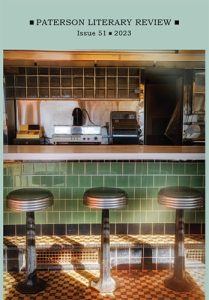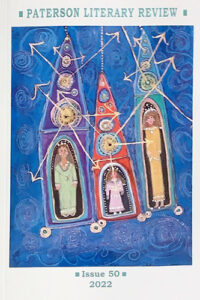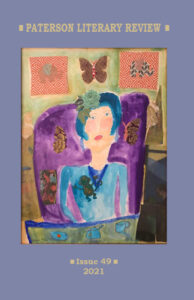Paterson Literary Review – 2010/2011
Issue 38
2010-2011
Annual
Sima Rabinowitz
More than 360 pages of poetry and prose selected from the 10,000 submissions the journal receives annually. A “spotlight” on Diane de Prima, including a short bio, a number of poems and a story, is followed by poems from more than 70 poets, 8 prose selections, reviews, and this year’s Allen Ginsberg Poetry Award winners and honorable mentions (another 40+ poets). The issue’s highlights include the magazine’s beautiful cover, an original oil painting by Robert Andriulli, “Mill Town Neighborhood.”
More than 360 pages of poetry and prose selected from the 10,000 submissions the journal receives annually. A “spotlight” on Diane de Prima, including a short bio, a number of poems and a story, is followed by poems from more than 70 poets, 8 prose selections, reviews, and this year’s Allen Ginsberg Poetry Award winners and honorable mentions (another 40+ poets). The issue’s highlights include the magazine’s beautiful cover, an original oil painting by Robert Andriulli, “Mill Town Neighborhood.”
The first-prize winning poem, “The Burning Bed,” by James D. Gwyn is representative of much of the work in this massive tome, in tone and style, if not form (a prose-poem hybrid). Like Gwyn’s opening line, “If I think about it enough, I can keep Farrah Fawcett out of my bed.”), most of the poems are conversational, composed of plain diction, personal, story-driven, inclined toward popular or familiar references and images, and read with ease.
Many, like Gwyn’s, are deceptively simply or easy going. (His litany of recent local fires burns down to, or perhaps I should say, sparks up to, a perfect conclusion: “Like I said. Everything is burning.”) When I finished the poem, I had to read it again. As with any good fire, it was hard to look away.
There is ample room here, of course, for enormous diversity in subject matter, perspective, and approach. “High culture” (Fran Castan’s “Vivaldi Concerti”) and “low” or popular culture (“Snoopy Hat” by Anthony Buccino) appear side by side, swooping birds and aisles of Jell-O, birdsong and Snoopy Red Baron “ack-ack noises” in close succession. There are, as we might expect, tragic family stories (Leslie Heywood’s “How to Bury Your First Born”) and the celebration of small victories (“the best twenty bucks I ever spent” by Jennifer Stoever-Ackerman); childhood memories (“July 2, 2002” by Lyn Lifshin) and personal triumphs (“Depression and Recovery” by Ellen Rowe: “It is sunshine. / It is a squirrel / hopping on a rooftop. / It is budding trees. / It is budding flowers. / It is / An Easter Basket!”).
Fiction entries are similar to the poetry in overall sensibility, readable, more traditional than inventive or unconventional in style and form, stories that center on solving a problem in a relationship or a personal dilemma, with recognizable or familiar characters.
The review includes a number of extremely well known and solidly established poets, including Jim Daniels, Marge Piercy, Lyn Lifshin, Stanley H. Barkin, Vivan Shipley, Gary Fincke, and Penelope Scambly Schott, among others, as well as many relative newcomers and dozens of poets on their way to stardom, widely published in journals with fine reputations.
The volume opens with Di Prima’s poem “First Draft: Poet Laureate Oath of Office” (she is poet laureate of San Francisco):
It is the poem I serve
luminous through time
that celebration
of human breath.
The poem is a fitting beginning to this blockbuster volume.
[www.pccc.edu/poetry]




